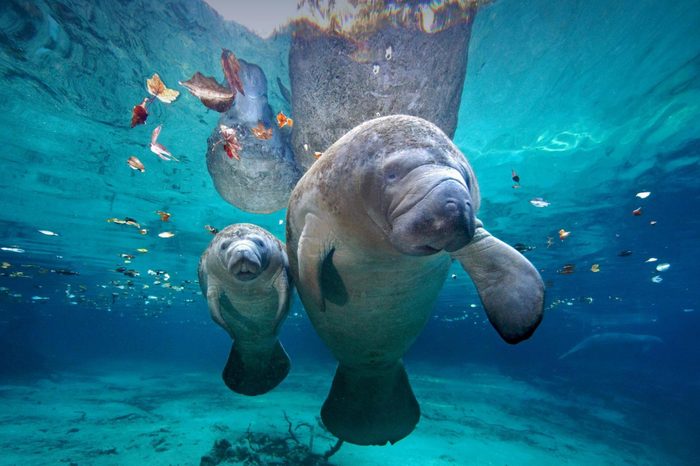
The teddy bears of the sea
Manatees, sometimes called the teddy bears of the sea, lead a pretty good life. They spend most of their days eating and sleeping. And even though the population is no longer declining, manatees are still a species that’s at risk and needs human protection. After all, we want to ensure we have plenty of manatees to appreciate during Manatee Awareness Month and all the months to come. Here are some fascinating facts about these adorable sea creatures you might be surprised to learn.
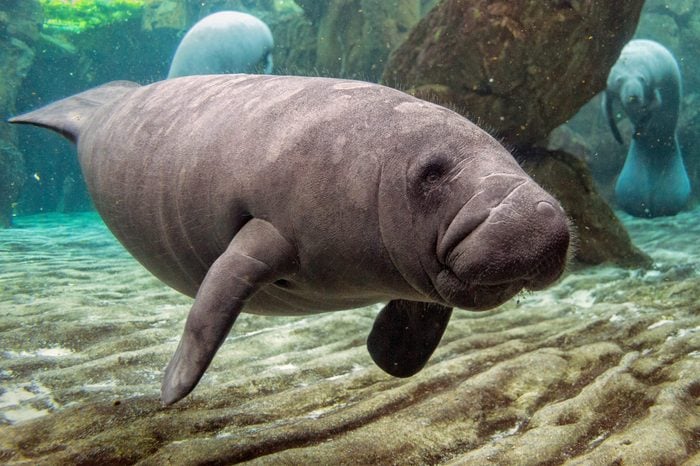
Manatees are the biggest vegetarians
And when we say the biggest, we mean that literally: Manatees are the largest herbivores in the entire ocean. National Geographic says they’re about 1,300 pounds and 14 feet long, though Defenders.org says they can grow to a whopping 1,800 pounds. There are three different types of manatees in the world, and they eat an amount equal to about 10 percent of their body weight every day. Manatees that live near the United States are vegetarians, eating plants like turtle grass and the leaves of mangroves, according to SeaWorld.org. However, the manatees that live in West Africa and in Central America sometimes supplement their veggie meals with clams and with fish they find in nets. Here are 60 more fun facts about animals you probably didn’t know before.
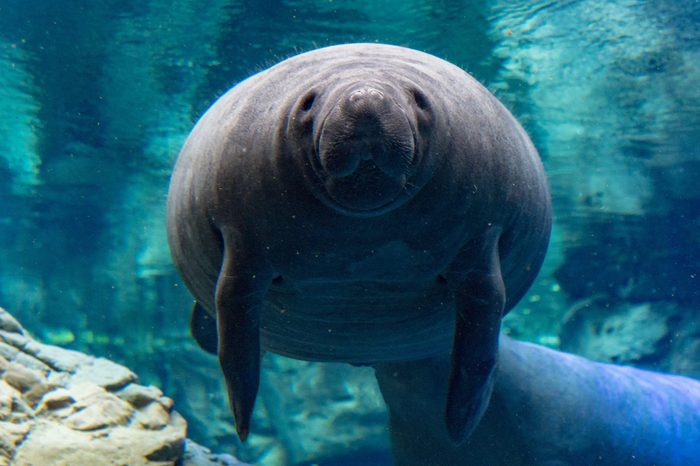
The West Indian manatee actually lives in America
Of the three types of manatees, the one that lives in the United States is called the West Indian manatee. These manatees are also found in the Caribbean, Central America, and northern coastal areas of South America. There are two subspecies of the West Indian manatee, according to Thoughtco.com: the Florida manatee, which lives off the coast of Florida and in the Gulf of Mexico, and the Antillean manatee, found in Central America and the Caribbean.
The West Indian manatee is the largest of the manatees. Their bodies are gray-brown, their snouts are quite broad, and they have lots of whiskers. They also have a flat tail that looks kind of like a paddle. Though they’re still at risk, the West Indian manatee is one of these 16 incredible animals that came back from the brink of extinction.
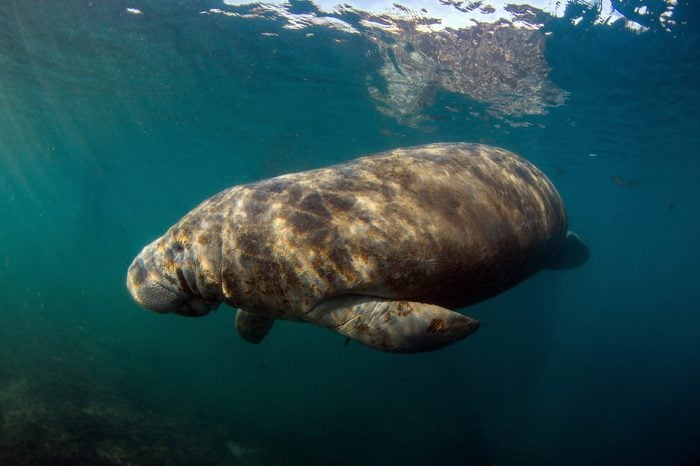
Africa has manatees, too
Another type of manatee is the West African manatee. They look similar to the West Indian type, although their snouts are blunter. Categorizing them as “vulnerable” since there are just 10,000 mature individuals left in the wild, the International Union for Conservation of Nature and Natural Resources (IUCN) says they’re found in countries like Ghana, Nigeria, and Senegal. On the bright side, these 11 other endangered animals are making a comeback—and will give you hope for the world.
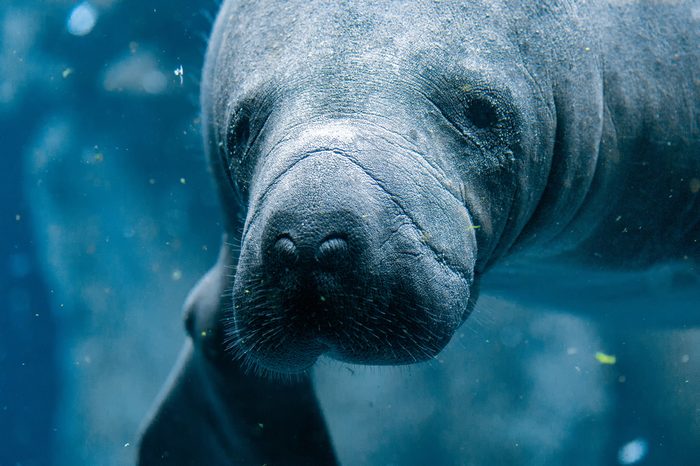
Not all manatees live in saltwater
The Amazonian manatee is the smallest type of manatee, growing to just about nine feet long and 1,100 pounds. Their skin is smooth and, unlike other manatees, they have no nails on their flippers. They are a freshwater species and live in and around the Amazon River. Their neighbors? These 17 animals that live only in the Amazon rainforest.
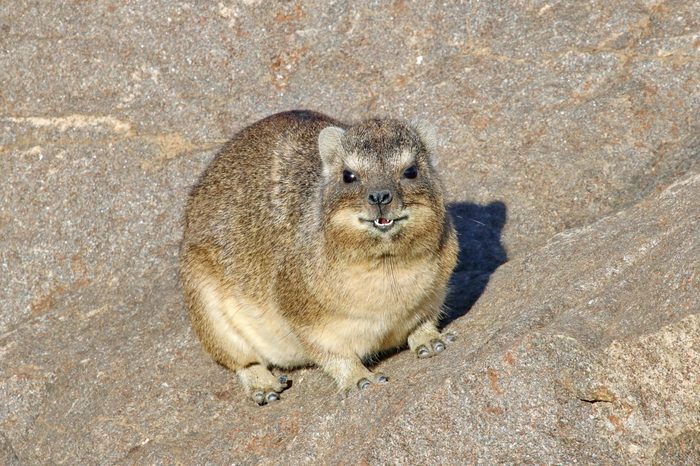
Manatees have unusual cousins
The dugong is closely related to the manatee, which you’d probably guess by looking at it. The dugong’s front half looks a lot like a manatee’s, but the dugong’s tail resembles that of a dolphin. Dugongs live in the waters around Egypt, Kenya, and Sri Lanka, across the Indian Ocean to Asian countries like Thailand and the Philippines, and as far south as Australia.
Manatees have some land relatives, too. Believe it or not, the elephant and the rock hyrax are manatee cousins. What’s a hyrax, you ask? Also called a dassie, this small gopher-like animal pops up in tourist-friendly places like Table Mountain in Cape Town, South Africa—which happens to be one of these 15 natural wonders you’ve (probably) never heard of.
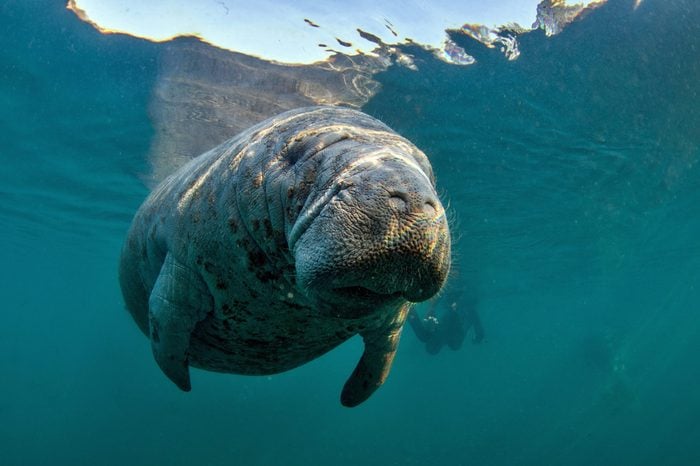
The first mermaids were actually manatees
Yes, you read that right. The myth of the mermaid likely originated with manatees. Mermaids have been characters in myths and stories at least as far back as Homer’s Odyssey, which was written in the 8th century BC, and many explorers thought that these unusual sea creatures (which they only got a glimpse of) were actually mermaids. According to the Smithsonian, Christopher Columbus made the first written recording of a manatee sighting—which he thought were three “mermaids”—in 1493. He wrote in the ship’s log that “they are not so beautiful as they are said to be.” It’s no wonder he thought that since what experts now believe he saw were actually the heads of curious manatees. The United States has its own mermaid myths, too. One of them even made this list of the 50 spookiest urban legends from every state.
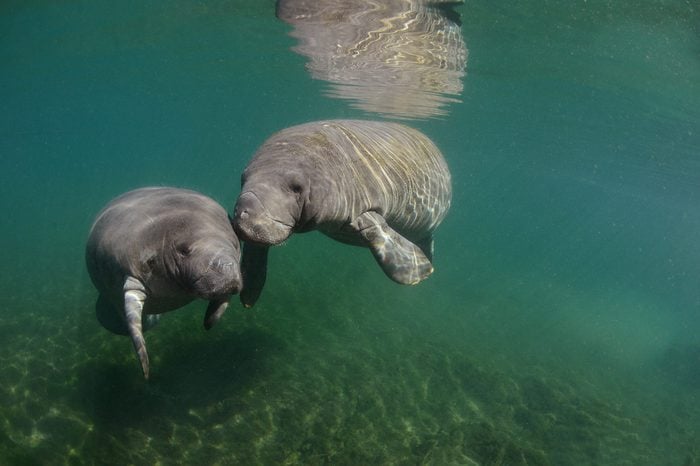
Manatees have a quirky nickname
Mermaids also contributed to the naming of manatees. Their scientific name is Sirenia, which is related to the word that many cultures use for mermaid—siren. Another nickname for the manatee is sea cow. There are many theories why. The U.S. Fish and Wildlife Service says it’s because manatees graze on seagrass, similar to how cows graze in a pasture. Others say it’s because the large mammals are docile and slow-moving like cows. Fun fact: A group of manatees is called an aggregation. Here are another 27 hilarious (but totally real) names for groups of animals.
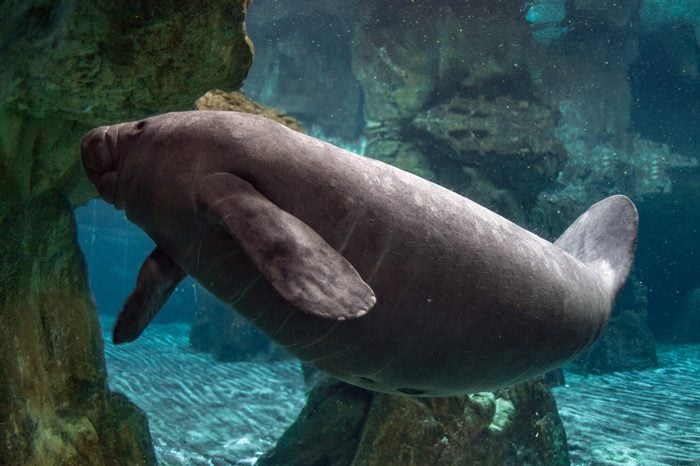
Manatees don’t have blubber
Manatees live in shallow, slow-moving waters, including oceans, rivers, estuaries, and even canals. Unlike most other sea mammals, such as dolphins and whales, manatees don’t have any blubber. Without any blubber, manatees have no protection from the cold. They don’t like it when their watery environment dips below 68 degrees, and, in fact, they can experience stress and hypothermia at these temperatures. Speaking of dolphins, here’s why they are some of the smartest creatures on the planet.
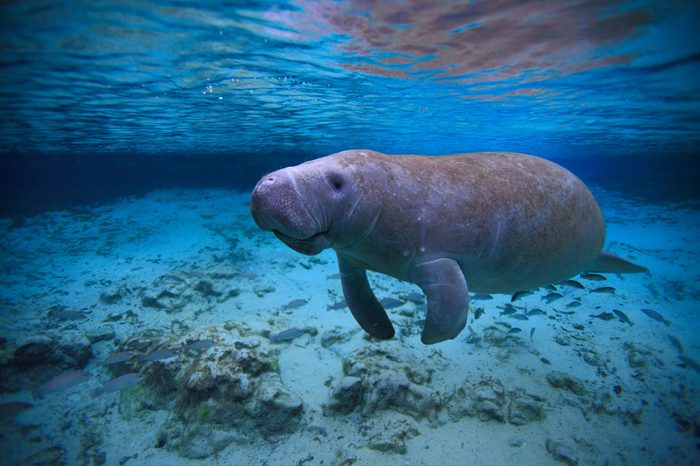
Manatees go to Florida for their winter vacation
Because they don’t like the cold, manatees migrate in the winter. In the United States, according to SaveTheManatees.org, wild manatees can be found as far north as Massachusetts and west into Texas. They’ve also been seen in South Carolina, Georgia, and Alabama. However, their favorite American home is Florida. Some live there year-round, and thousands more migrate to Florida during the winter because they like Florida’s warm water. (Who doesn’t?) Citrus County, on Florida’s west coast, is one of their favorite spots. Of course, manatees are not the only species that migrate.
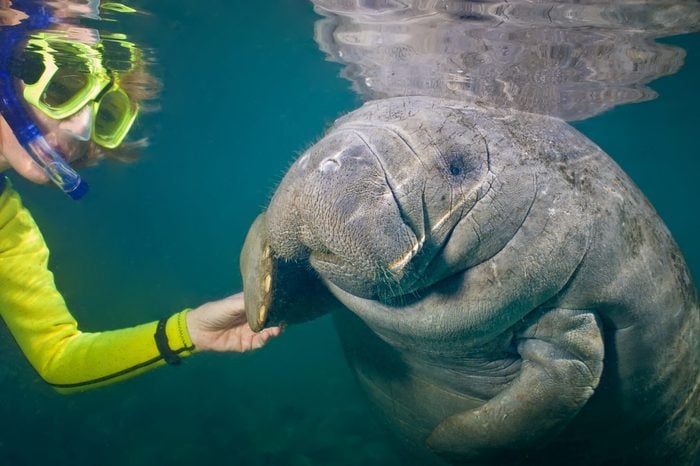
It’s illegal to hug a manatee
According to the U.S. Fish and Wildlife Service, West Indian manatees are classified as threatened. They estimate that only about 13,000 manatees remain in the world, with about 6,500 in the United States, mostly in Floridian waters. Manatees are protected under the Endangered Species Act and the Marine Mammal Protection Act. This means no hugging, and, in fact, not disturbing them at all. Actually, that’s a good rule of thumb for any wildlife. Aside from personal-safety issues, more animals than you realize are at risk. For example, these are 14 wild animal species you never knew were endangered.
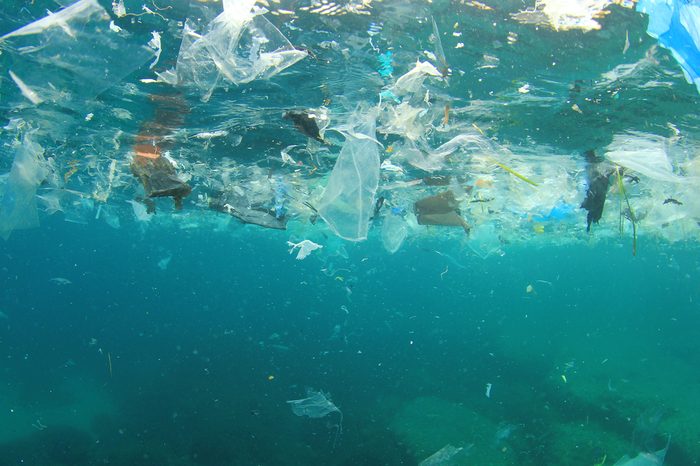
These are the biggest threats to manatees
The greatest threat to manatees is loss of habitat, according to Defenders.org. Habitat loss comes from developing wetlands for human use, from climate change, from blooms of poisonous algae, and from pollution. Manatees can also get trapped in small areas, particularly after a very high tide, as well as get entangled in fishing gear. Plus, manatees don’t swim very fast, so they’re also susceptible to being hit by fast-moving boats.
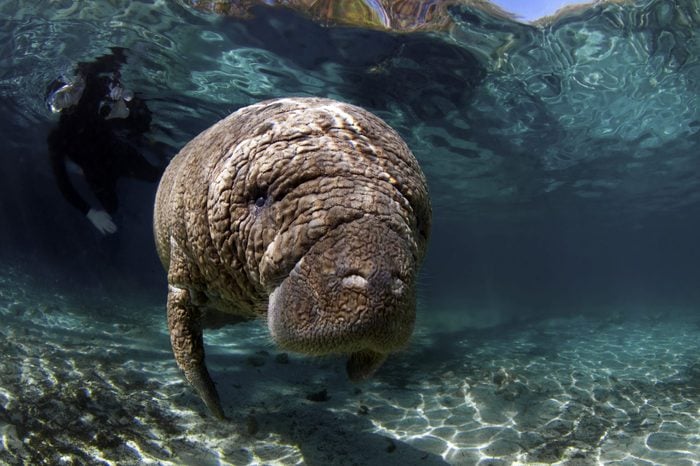
Manatees need rescuing
Many organizations work to save manatees. For example, SeaWorld Orlando has a five-acre manatee rescue and rehabilitation facility that treats orphaned, ill, and injured animals. A portion of the facility is open for visitors to learn about the risks manatees face and the simple things that we can do to help these gentle giants. What else can you do to help animals in need? A lot, as it turns out, especially for an animal like the rhino. This is how many rhinos are left in the world—and what you can do to help them.
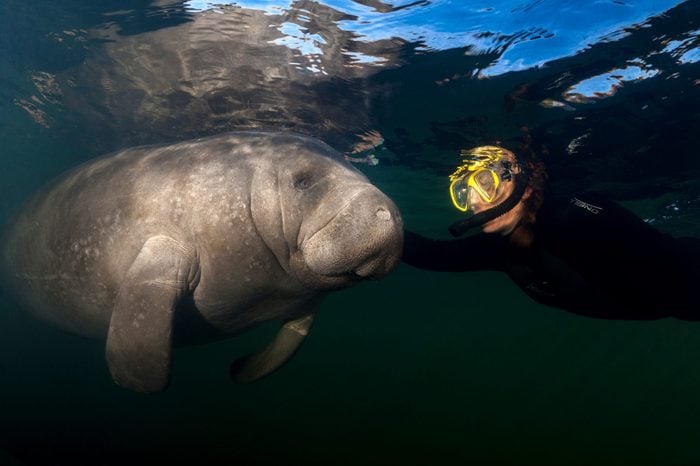
There’s only one place in the United States where you can legally swim with manatees
Prime manatee swimming spots are in Citrus County near the towns of Crystal River and Homosassa, about an hour and a half west of Orlando. The greatest numbers of manatees in this area are seen in January and February. Visitors can snorkel or scuba dive with the manatees, which mostly ignore humans. If you’d rather remain dry, you can also admire manatees from kayaks and stand-up paddleboards. There are even two spots that have viewing boardwalks: at Crystal River’s Three Sisters Springs and at the Ellie Schiller Homosassa Springs Wildlife State Park.
